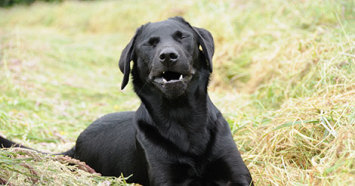
Just like people, dogs can sneeze for many reasons. Some reasons are no cause for concern, like an occasional sneeze if your dog snorts up too much dust or pollen. Sneezing is the body’s normal reaction to this because it helps to keep the airways clear. Another example of a normal sneeze is a “photic sneezing reflex.” Animals and humans have a natural tendency to sneeze when they are suddenly exposed to a bright light, usually sunlight. However, sneezing can also be caused by more serious issues. If the sneezing becomes frequent and your dog has watery eyes, a runny nose, and/or poor appetite, you may want to get him or her checked out by your veterinarian.
Allergies
Another very common cause of sneezing in dogs is allergic rhinitis. Dogs can be allergic to just about anything, including pollens, dust, mold, and, believe it or not, human dander. If your dog’s sneezing accompanies seasonal changes, it could be linked to springtime allergies. In order to differentiate allergies from infection, your veterinarian will likely need to run several tests. He or she may also need to refer your dog to a veterinary dermatologist for specialized skin tests. This will determine what your pet’s allergies are.
Dental Disease
Another extremely common cause of sneezing in dogs is tooth decay. Because of the shape of a dog’s mouth, the teeth in the mandible (i.e., upper jaw) are extremely close to the nasal cavity (i.e., the nasal passageways). If dental disease becomes severe enough, even if the problem is not obvious to the naked eye, tooth infections can create a hole from the mouth leading into the nasal cavity. This is called an oronasal fistula and often requires removal of the diseased tooth and oral surgery to fix the hole. The most common teeth that cause oronasal fistulas are the upper canine teeth. Dachshunds seem to develop this issue frequently compared to other dog breeds.
Nasal Foreign Bodies
Because dogs use their noses to sniff and snuffle their way along the ground, it is not uncommon for them to accidentally sniff something up their nose. Common foreign bodies (i.e., objects that shouldn’t be in the nose) are grass awns or grass seeds. Another way a dog could develop a nasal foreign body is by eating something and inhaling or coughing it up the back of the nose. Unfortunately, to diagnose (and often remove) a nasal foreign body, specialized tools and imaging may be required such as an endoscope, which is a flexible tube with a camera on the end that can fit through the nose or the back of the mouth.
Can dogs get colds?
Yes and no. Colds in humans are caused by certain types of viruses that affect the upper respiratory tract (i.e., the nasal passages, mouth, and throat). The most common type of cold virus people catch is called a rhinovirus. Dogs can also get upper respiratory tract infections, but they do not get the same colds as people. For clarity, and because the “common cold” we hear about refers to the rhinovirus type, people in veterinary medicine don’t often use the term “cold.”
Upper respiratory tract symptoms in dogs can be similar to that in people:
Runny nose
Sneezing
Watery eyes
Coughing
Poor appetite
Lethargy
Bacteria and viruses that cause these cold-like symptoms in dogs include canine distemper virus, canine coronavirus, kennel cough syndrome (a group of bacteria and viruses including Bordatella bronchiseptica and parainfluenza virus), canine adenovirus type 2, canine influenza virus, and canine herpes virus.